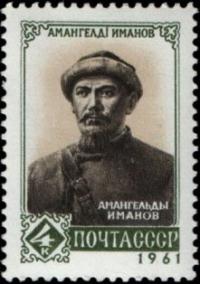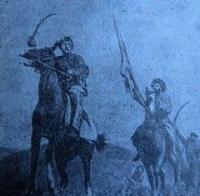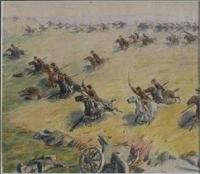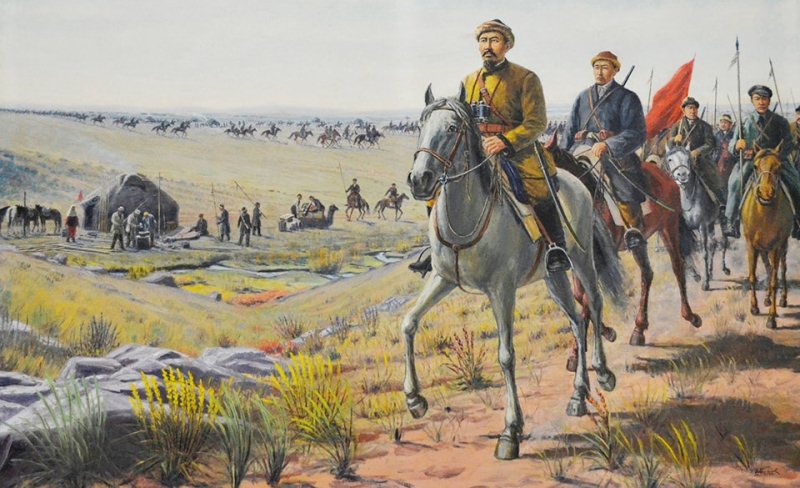Вы здесь
Amangeldy Imanov (1873 - 1919).




Historical tours in Kazakhstan.
“You must not succumb to weakness:
There are no roads for easy exploits"
Dante Alighieri, The Divine Comedy.
The Great Silk Road Central Asia.
Amangeldy Uderbaiuly Imanov - people's batyr, organizer of the national liberation uprising of the Kazakh people in 1916 against tsarism and an active participant in the establishment of Soviet power in Kazakhstan.
Was born on April 3, 1873 in the territory of the modern Amangeldi district of Kostanay region in a poor family. He grew up an orphan: he worked as a laborer, saw the plight of the people. Until the age of 12 he studied at the aul school, then at the Ishanov Tasybay and Tashmagambet madrasah.
Here he studied for four years, mastered Turkish, Persian, Arabic languages. In 1910, in Terisbutak, where Amangeldy's family lived, a school was built on his initiative. Even before the 1916 uprising, Amangeldy was known in the steppe as a champion of people's freedom, an opponent of the colonial regime.
Under the influence of the liberation ideas of the first Russian revolution of 1905-1907, he takes part in the armed struggle of the poor against the beys. Having established close ties with a group of Bolsheviks, A. Imanov became famous throughout the Turgai steppe as the organizer of the national liberation struggle of the peasant masses.
In 1896 - 1908 the tsarist government repeatedly put him in prison, considering him unreliable. More than once A. Imanov had to travel to St. Petersburg on the affairs of Kazakh prisoners. Amangeldy is a typical representative of the advanced strata of the Kazakh labor sharua (poor peasants) of the early XXth century.
Thanks to his active participation in the social life of the village, which contributed to its significant political development, he stood in the forefront of the liberation movement. In the midst of the upsurge of the revolutionary movement in tsarist Russia in 1916, an uprising began in Kazakhstan and Central Asia. The reason for the uprising in Kazakhstan was the decree of Tsar Nicholas II of June 25, 1916, called "requisition", on the call of Kazakhs aged 19 - 43 for front-line trench work.
During the uprising, A. Imanov showed himself as a staunch fighter, convinced of the anti-popular nature of state power. The uprising had political significance, was directed against the colonial policy of the tsarist government, was aimed at the liberation of the people and continued until the February Revolution in Russia.
The number of sarbaz (warriors) who participated in it was 50 thousand people. In October 1916, only in the Torgai and Irgiz districts, about 20 detachments were formed. Amangeldy established strict discipline in the units, taught the rebels to use weapons and demanded that they learn the rules of warfare.
The rebels organized several attacks against the local authorities of the tsarist government and surrounded the city of Torgai. Amangeldy's organizational and military talents were clearly manifested in this operation. His sarbazes showed an example of fearlessness and determination.
The tsarist government was forced to send punitive troops to repulse the soldiers of Amangeldy. Only after the arrival of the main armed forces of the enemy, after 27 days, Amangeldy withdrew his army. In January 1917, he again took action to capture the city, but was forced to retreat, since the forces were unequal.
At this time, Amangeldy began to be imbued with the advanced ideas of the Bolshevik Party. Having established contact with the Bolsheviks, he organized a struggle against the Alashorda people, whom he considered to be preachers of the ideas of a provisional government, and explained to the masses the essence of the proletarian revolution.
In October 1917 - January 1918, Amangeldy actively participated in the establishment of Soviet power in Torgai and the Torgai region (now the Kostanay region), was a military commissar of the Torgai district. He joined the ranks of the Bolsheviks under the influence of Alibi Zhangeldin. In March 1918 he took part in the work of the regional congress of Soviets (Orenburg, 1918).
In July 1918, at the head of a group of Soviet workers, he held elections for aul and volost Soviets. During the Civil War, together with A. Zhangeldin, he formed the first national Red Army units in Kazakhstan, helped the partisans in the rear of Kolchak's troops.
After the liquidation of Soviet power in Torgay on April 20, 1919, A. Imanov was taken prisoner. The residents of Alashchorda killed him a few hours before the Red Army entered the town. A. Imanov was buried in Alakol, in 1940 he was reburied in the regional center.
There is a monument on the grave. He had two sons - Ramazan and Sharipa. The life and struggle of Amangeldy is reflected in the works of poets and writers, artists, composers, filmmakers. Zhambyl Zhabayev, Omar Shipin and other akyns dedicated their poems and poems to Amangeldy.
The writer G. Musrepov created an artistic image of the national batyr in the play "Amangeldy". Folk artists A. Kasteev (portrait "Amangeldy", paintings "Offensive Amangeldy "," Torgai campaign ") and K. Telzhanov (" Amangeldy ") created the image of a batyr in the visual arts.
In 1938, director M. Levin made the film "Amangeldy". In 1947, a bronze monument - an equestrian statue - was erected in Almaty to batyr. A district in the Kostanay region was named after him, monuments were erected and streets in many cities of Kazakhstan were named.

Authority:
http://www.tarih-begalinka.kz/ru/history/revolution/figures/imanov/







